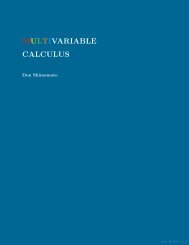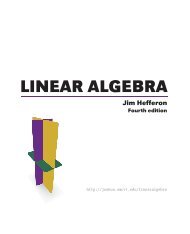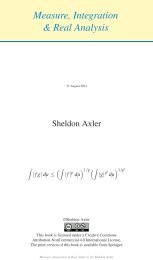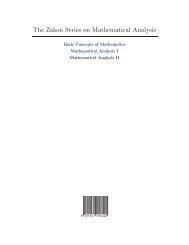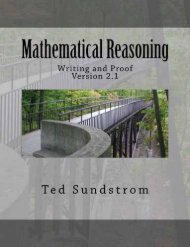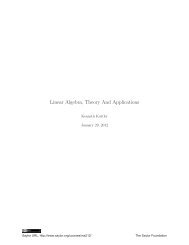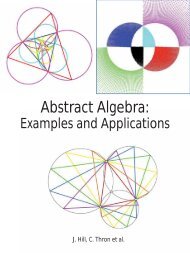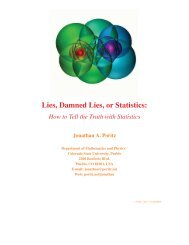University Physics I - Classical Mechanics, 2019
University Physics I - Classical Mechanics, 2019
University Physics I - Classical Mechanics, 2019
You also want an ePaper? Increase the reach of your titles
YUMPU automatically turns print PDFs into web optimized ePapers that Google loves.
10.5. ADVANCED TOPICS 247<br />
10.5 Advanced Topics<br />
10.5.1 Tidal Forces<br />
Throughout this chapter we have treated the objects interacting gravitationally as if they were<br />
particles, that is to say, as if they were non-deformable and their shape and relative orientation<br />
did not matter. However, these conditions are never quite realized in real life. Some planets, like<br />
our own Earth, are particularly susceptible to deformation, because of the large amount of fluid<br />
matter on their surface, and even rocky planets and moons are sensitive to tidal forces, whichare<br />
the differences on the gravitational pull by the central attractor on different parts of the object<br />
considered.<br />
IfyoulookbackonFigure10.1, for instance, it is easy to see that the moon must be pulling more<br />
strongly on the side of the Earth that is closer to it (the left side, on that picture) than on the<br />
farther side. This is, of course, because the force of gravity depends on the distance between the<br />
interacting objects, and is stronger when the objects are closer. You can easily calculate that the<br />
force by the moon on a given volume of Earth (say, a cubic meter) is about 7% stronger on the near<br />
side than on the far side. A deformable object subject to such a pair of forces will naturally be<br />
stretched along the direction of the pull: in the case of the Earth, this “stretching” affects primarily<br />
the water in the oceans that cover most of the surface, resulting in two “tidal bulges” that account<br />
for the well-known phenomenon of tides: as the earth rotates around its axis, each point on the<br />
surface passes through one of the bulges once a day, resulting in two high tides each day (and, in<br />
between, a comparatively lower water level, or low tide, twice a day as well). 5<br />
For many objects in the solar system, this tidal stretching has, over millions of years, resulted in a<br />
permanent deformation. The tidal forces by the Earth on the moon are weaker than those by the<br />
moon on the Earth (since the moon is much smaller, the difference between the Earth’s pull on the<br />
moon’s near and far side is less than 1.5%), but at a time when the moon was more malleable than<br />
at present, it was enough to produce an elongation along the Earth-moon axis that is now pretty<br />
much frozen in place.<br />
Once a satellite (I will use the term generically to refer either to a planet orbiting the sun, or a moon<br />
orbiting a planet) becomes permanently deformed, a new phenomenon, known as tidal locking, can<br />
happen. Suppose the satellite is rotating around its own axis, in addition to orbiting around the<br />
primary body. As you can see from the figure below, if the rotation is too fast, the gravitational<br />
5 You may ask, besides being stretched, shouldn’t the net pull of the moon cause the Earth to fall towards it?<br />
The answer is that the Earth does not fall straight towards the moon, for the same reason the moon does not fall<br />
straight towards the Earth: both have a sideways velocity that keeps them in a steady orbit, for which the net<br />
gravitational pull provides the centripetal force. Both actually orbit around the center of mass of the system, which<br />
is located about 1, 690 km under the Earth’s surface; the Earth’s orbit (and its orbital velocity) is much smaller than<br />
the moon’s, by virtue of its much larger mass, of course.





